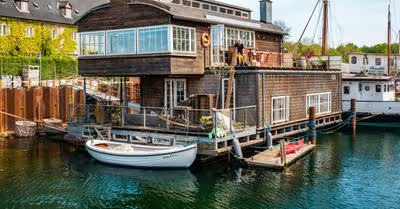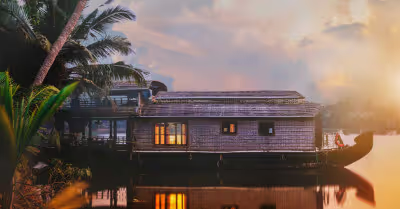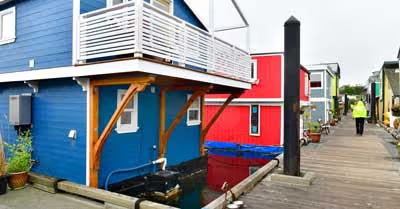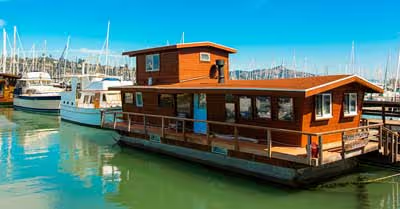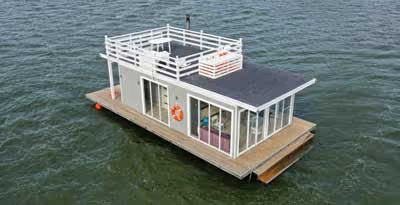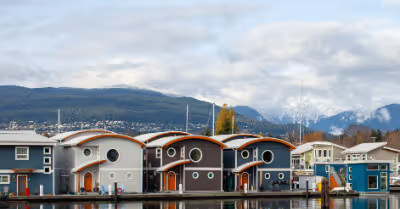
Buying a houseboat depends on your needs and the people living in it. As such, you need to know about the various houseboat sizes to make the right decision.
Depending on how many people will be living on the houseboat, you may get the 59' Deluxe or the 60' Eagle, all of which are considered the go-to choices for those looking for a houseboat. For two people, 40' to 60' will give you plenty of room to roam around inside without bumping into each other.
Thanks to the popularity of houseboats, and many folks calling a houseboat their full-time home, there is no shortage of options when it comes to houseboat types and sizes. While this is a good thing, it can also make it difficult for new houseboat buyers to choose the best option.
If you've been thinking about what houseboat sizes suit you, then you could use our experience as houseboat owners to determine what factors need to be considered when choosing the right-sized houseboat for your needs.
What Makes a Houseboat?
Houseboats are well-known to many people; in fact, it wouldn't be wrong to say that generations of families have some great memories of the time they spent during the summer holidays on a houseboat. For many of us, the houseboat is where we first discovered our love for boating or fishing. In general, houseboats are big vessels designed with a focus on comfort rather than efficiency. That's because, unlike other boat types, houseboats mostly stay docked at a lake, harbor, or marina.
Unlike traditional boats or bigger yachts, houseboats are intended to be used as residences on the water rather than modes of transportation. This is the reason why houseboats tend to have a variety of propulsion systems, which mainly depends on the size and type of the houseboat. But they all include one more motor. On some versions, you'll find them with inboard, stern drive, or outboard motors. Technically speaking, if a vessel lacks an engine and propulsion system, it is usually referred to as a floating house rather than a houseboat.
Houseboats Sizes
Just like when you go to buy a car and have to choose from the multiple types and sizes that are available, buying a houseboat also requires the same amount of effort. The majority of houseboats are between 30 and 100 feet long and 8 to 20 feet wide. The 40′ and 50′ versions are two of the most popular houseboat sizes.
That's a huge range, but there are a lot of different manufacturers and many people who are looking for a houseboat with a variety of features. Some people only want a small platform with a shanty where they may fish on weekends. Others desire a large houseboat with all of the comforts of home and plenty of activities.
First-time buyers need to be aware that the length of most houseboats is more important than the space of their living area. As a result, many postings just specify the boat's length rather than its breadth or square area. For these details, you'll almost always have to call the dealer. However, if you're looking at a lot of possibilities, you might not have time to contact them all individually. In such a scenario, keep in mind that each foot length normally represents 8 to 20 square feet, with up to 80% more area if the boat has two floors or decks.
A luxury houseboat's usual length is roughly 50 feet, although some are much longer, while smaller versions can be as little as 20 feet in length. However, it should be noted that almost all of the houseboats that are available on the market are between 30 and 60 feet long, with a handful reaching 120 feet or more. When choosing the size of the houseboat you are about to buy, it is always best to consider that tides and winds can affect your handling of the craft because it has so much mass.
So, it's best to shop for one that you can handle. One of the best ways of finding what size houseboat is right for you in terms of mobility and control is to ask people you know if you can get behind the wheel of their houseboat to find out how in control you are of the vessel.
Finding the Right Size
The first step in purchasing any form of boat or houseboat is determining the appropriate size. When calculating this, several aspects come into play, including the size of your family or group, as well as your personal preferences.
What you want to use it for is one of the most important considerations you need to factor in when deciding on the houseboat you want to buy. If having a large living room and entertainment area is important to you, the larger houseboats are the way to go. If you plan to live on your houseboat all year, you may need to do the same. However, you ideally want to pick a smaller option that will be suitable for weekend vacations on the lake or for a couple that wants to downsize.
Normally, a family or group of friends would require a 40-foot houseboat to be comfortable and have adequate space for supplies. However, they are only estimations that might vary depending on the boat's configuration.
Houseboat Types
When getting a houseboat, it is also important to make sure that you choose the right type of houseboat for your specific needs. Of course, not all people look for the same things when buying a houseboat, so there is a large market that's home to various houseboats. To make sure you invest in the perfect houseboat, you must also consider the various types of liveaboards available. To make it easier on you, here are a few different types of houseboats that you will find during your search for the perfect houseboat.
Catamaran Houseboat
Because both feature a float on either side to support the houseboat, a catamaran houseboat and a pontoon houseboat are frequently mistaken for one another. However, one of the major distinctions is that with a catamaran, you can use the hull area for storage, but on a pontoon-style houseboat, you can't. Catamarans are known for their excellent handling and smooth rides.
Catamarans are built in a number of ways, but the most common is with a seamless mold that creates one solid piece of hull. Because there is significantly less drag, the catamaran will handle better than a full hull houseboat. The hull of a catamaran is normally built of fiberglass, making it considerably easier to maintain than other hull materials.
Full Hull
One of the more popular types of houseboats is the full hull. The storage capacity in the hull isn't that great, but you can also take it anywhere hassle-free. Furthermore, in the case of a storm, a full hull houseboat is able to sit higher on the water, so you won't have to bother too much about the water coming into the boat as you would with a pontoon-style houseboat. Depending on the sort of water you'll be traveling in, full hull houseboats come in a number of forms.
Trailerable Houseboats
Trailerable houseboats are those that can be taken out of the water and placed on a trailer. These houseboats are often shorter in length and height since they must fit on a trailer while being towed while also being able to go on the road.
If you just use your boat on long weekends or during the summer, trailerable houseboats might be useful. Having a larger boat is good when you're out on the lake, but paying dock fees all year may quickly mount up. When you have a trailerable houseboat, you may store it in your driveway or yard and avoid paying such fees.
Trailerable houseboats have the disadvantage of being smaller than boats that are left on the water. Trailerable houseboats are typically 20-30 feet long. Some may be a little longer than others. Some may be a little longer or shorter, but that size allows you to easily climb on and off a trailer while still having enough space on board. Because it is obviously considerably smaller than a regular houseboat (which is usually 40-50 feet long), you must evaluate whether the reduced room onboard is worth it in order to trailer your houseboat.
Pontoon Houseboats
For those of you who don't know, a houseboat built on top of a pontoon base is known as a pontoon houseboat. A pontoon houseboat comes in a range of sizes, making it the most popular kind of houseboat. There are pontoon houseboats as little as 20 feet long and as large as 65-75 feet long! One disadvantage of pontoon houseboats is that they usually ride lower in the water, which might be an issue if you're stuck on a lake or river during a storm.
Stationary Houseboats
And finally, the last and one of the most popular types of houseboats that you will find is pretty self-explanatory. A motionless houseboat is, well, a stationary houseboat. There are several locations where houseboats may be parked permanently and never move. Some houseboats are permanently moored on the water. These can be found on private lakes or even on river backwaters' docks.
The biggest disadvantage of a fixed houseboat is that it does not move. Rather than being recreational vessels, they are more commonly utilized as floating houses. Another difficulty with stationary houseboats is that getting water, power, sewage, and other services might be difficult unless you own the property where the boat is parked.
Looking at various models separately is the best way to select the houseboat that is right for you. It would be much better if you could rent the houseboat or a comparable type for a week. Then there's the issue of your financial situation. It is always important to consider the cost of the houseboat. However, houseboat costs range from a few thousand dollars for older and smaller boats to several million dollars for luxury yachts.
Keeping that in mind, there are many factors that influence the price of a houseboat. This also includes the manufacturer, whether it is new or used, the quality of the materials used during the manufacturing, and any added features. So, if you weren't quite sure about the houseboat sizes or which one to invest in, you can now use this guide to make a more informed decision.



